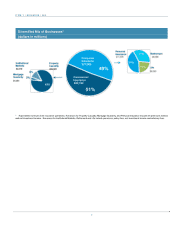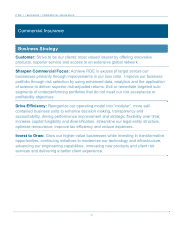AIG 2015 Annual Report Download - page 19
Download and view the complete annual report
Please find page 19 of the 2015 AIG annual report below. You can navigate through the pages in the report by either clicking on the pages listed below, or by using the keyword search tool below to find specific information within the annual report.-
 1
1 -
 2
2 -
 3
3 -
 4
4 -
 5
5 -
 6
6 -
 7
7 -
 8
8 -
 9
9 -
 10
10 -
 11
11 -
 12
12 -
 13
13 -
 14
14 -
 15
15 -
 16
16 -
 17
17 -
 18
18 -
 19
19 -
 20
20 -
 21
21 -
 22
22 -
 23
23 -
 24
24 -
 25
25 -
 26
26 -
 27
27 -
 28
28 -
 29
29 -
 30
30 -
 31
31 -
 32
32 -
 33
33 -
 34
34 -
 35
35 -
 36
36 -
 37
37 -
 38
38 -
 39
39 -
 40
40 -
 41
41 -
 42
42 -
 43
43 -
 44
44 -
 45
45 -
 46
46 -
 47
47 -
 48
48 -
 49
49 -
 50
50 -
 51
51 -
 52
52 -
 53
53 -
 54
54 -
 55
55 -
 56
56 -
 57
57 -
 58
58 -
 59
59 -
 60
60 -
 61
61 -
 62
62 -
 63
63 -
 64
64 -
 65
65 -
 66
66 -
 67
67 -
 68
68 -
 69
69 -
 70
70 -
 71
71 -
 72
72 -
 73
73 -
 74
74 -
 75
75 -
 76
76 -
 77
77 -
 78
78 -
 79
79 -
 80
80 -
 81
81 -
 82
82 -
 83
83 -
 84
84 -
 85
85 -
 86
86 -
 87
87 -
 88
88 -
 89
89 -
 90
90 -
 91
91 -
 92
92 -
 93
93 -
 94
94 -
 95
95 -
 96
96 -
 97
97 -
 98
98 -
 99
99 -
 100
100 -
 101
101 -
 102
102 -
 103
103 -
 104
104 -
 105
105 -
 106
106 -
 107
107 -
 108
108 -
 109
109 -
 110
110 -
 111
111 -
 112
112 -
 113
113 -
 114
114 -
 115
115 -
 116
116 -
 117
117 -
 118
118 -
 119
119 -
 120
120 -
 121
121 -
 122
122 -
 123
123 -
 124
124 -
 125
125 -
 126
126 -
 127
127 -
 128
128 -
 129
129 -
 130
130 -
 131
131 -
 132
132 -
 133
133 -
 134
134 -
 135
135 -
 136
136 -
 137
137 -
 138
138 -
 139
139 -
 140
140 -
 141
141 -
 142
142 -
 143
143 -
 144
144 -
 145
145 -
 146
146 -
 147
147 -
 148
148 -
 149
149 -
 150
150 -
 151
151 -
 152
152 -
 153
153 -
 154
154 -
 155
155 -
 156
156 -
 157
157 -
 158
158 -
 159
159 -
 160
160 -
 161
161 -
 162
162 -
 163
163 -
 164
164 -
 165
165 -
 166
166 -
 167
167 -
 168
168 -
 169
169 -
 170
170 -
 171
171 -
 172
172 -
 173
173 -
 174
174 -
 175
175 -
 176
176 -
 177
177 -
 178
178 -
 179
179 -
 180
180 -
 181
181 -
 182
182 -
 183
183 -
 184
184 -
 185
185 -
 186
186 -
 187
187 -
 188
188 -
 189
189 -
 190
190 -
 191
191 -
 192
192 -
 193
193 -
 194
194 -
 195
195 -
 196
196 -
 197
197 -
 198
198 -
 199
199 -
 200
200 -
 201
201 -
 202
202 -
 203
203 -
 204
204 -
 205
205 -
 206
206 -
 207
207 -
 208
208 -
 209
209 -
 210
210 -
 211
211 -
 212
212 -
 213
213 -
 214
214 -
 215
215 -
 216
216 -
 217
217 -
 218
218 -
 219
219 -
 220
220 -
 221
221 -
 222
222 -
 223
223 -
 224
224 -
 225
225 -
 226
226 -
 227
227 -
 228
228 -
 229
229 -
 230
230 -
 231
231 -
 232
232 -
 233
233 -
 234
234 -
 235
235 -
 236
236 -
 237
237 -
 238
238 -
 239
239 -
 240
240 -
 241
241 -
 242
242 -
 243
243 -
 244
244 -
 245
245 -
 246
246 -
 247
247 -
 248
248 -
 249
249 -
 250
250 -
 251
251 -
 252
252 -
 253
253 -
 254
254 -
 255
255 -
 256
256 -
 257
257 -
 258
258 -
 259
259 -
 260
260 -
 261
261 -
 262
262 -
 263
263 -
 264
264 -
 265
265 -
 266
266 -
 267
267 -
 268
268 -
 269
269 -
 270
270 -
 271
271 -
 272
272 -
 273
273 -
 274
274 -
 275
275 -
 276
276 -
 277
277 -
 278
278 -
 279
279 -
 280
280 -
 281
281 -
 282
282 -
 283
283 -
 284
284 -
 285
285 -
 286
286 -
 287
287 -
 288
288 -
 289
289 -
 290
290 -
 291
291 -
 292
292 -
 293
293 -
 294
294 -
 295
295 -
 296
296 -
 297
297 -
 298
298 -
 299
299 -
 300
300 -
 301
301 -
 302
302 -
 303
303 -
 304
304 -
 305
305 -
 306
306 -
 307
307 -
 308
308 -
 309
309 -
 310
310 -
 311
311 -
 312
312 -
 313
313 -
 314
314 -
 315
315 -
 316
316 -
 317
317 -
 318
318 -
 319
319 -
 320
320 -
 321
321 -
 322
322 -
 323
323 -
 324
324 -
 325
325 -
 326
326 -
 327
327 -
 328
328 -
 329
329 -
 330
330 -
 331
331 -
 332
332 -
 333
333 -
 334
334 -
 335
335 -
 336
336 -
 337
337 -
 338
338 -
 339
339 -
 340
340 -
 341
341 -
 342
342 -
 343
343 -
 344
344 -
 345
345 -
 346
346 -
 347
347 -
 348
348 -
 349
349 -
 350
350 -
 351
351 -
 352
352 -
 353
353 -
 354
354 -
 355
355 -
 356
356 -
 357
357 -
 358
358 -
 359
359 -
 360
360 -
 361
361 -
 362
362 -
 363
363 -
 364
364 -
 365
365 -
 366
366 -
 367
367 -
 368
368 -
 369
369 -
 370
370 -
 371
371 -
 372
372 -
 373
373 -
 374
374 -
 375
375 -
 376
376
 |
 |

ITEM 1 / BUSINESS
19
A REVIEW OF LIABILITY FOR UNPAID LOSSES AND LOSS ADJUSTMENT EXPENSES
The liability for unpaid losses and loss adjustment expenses (also referred to as loss reserves) represents the accumulation of
estimates for unpaid reported losses (case reserves) and losses that have been incurred but not reported (IBNR) for the Non-
Life Insurance Companies and Eaglestone Reinsurance Company, including the related expenses of settling those losses.
We recognize as assets the portion of this liability that is expected to be recovered from reinsurers. Loss reserves are
discounted, where permitted, in accordance with U.S. GAAP.
The Loss Reserve Development Process
The process of establishing the liability for unpaid losses and loss adjustment expenses is complex and imprecise because it
must take into consideration many variables that are subject to the outcome of future events. As a result, informed subjective
estimates and judgments about our ultimate exposure to losses are an integral component of our loss reserving process.
We use a number of techniques to analyze the adequacy of the established net
liability for unpaid losses and loss adjustment expenses (net loss reserves). Using
these analytical techniques, we monitor the adequacy of our established reserves
and determine appropriate assumptions for inflation and other factors influencing
loss costs. Our analyses also take into account emerging specific development
patterns, such as case reserve redundancies or deficiencies and IBNR emergence.
We also consider specific factors that may impact losses, such as changing trends
in medical costs, unemployment levels and other economic indicators, as well as
changes in legislation and social attitudes that may affect decisions to file claims or
the magnitude of court awards. See Item 7. MD&A — Critical Accounting Estimates
for a description of our loss reserving process.
Because reserve estimates are
subject to the outcome of future
events, changes in prior year
estimates are unavoidable in the
insurance industry. These changes
in estimates are sometimes referred
to as “prior year loss development”
or “reserve development.”
A significant portion of the Non-Life Insurance Companies’ reserves are for the U.S. commercial casualty class, including
excess casualty, asbestos and environmental, which tends to involve longer periods of time for the reporting and settlement of
claims than other types of insurance and therefore may increase the inherent risk and uncertainty with respect to our loss
reserve development.
Analysis of Consolidated Loss Reserve Development
The “Analysis of Consolidated Loss Reserve Development” table presents the development of prior year net loss reserves for
calendar years 2005 through 2015 for each balance sheet in that period. The information in the table is presented in
accordance with reporting requirements of the Securities and Exchange Commission (SEC). This table should be interpreted
with care by those not familiar with its format or those who are familiar with other loss development analyses arranged in an
accident year or underwriting year basis rather than the balance sheet, as shown below. See Note 12 to the Consolidated
Financial Statements.
The top row of the table shows Net Reserves Held (the net liability for unpaid losses and loss adjustment expenses) at each
balance sheet date, net of discount. This liability represents the estimated amount of losses and loss adjustment expenses for
claims arising in all years prior to the balance sheet date that were unpaid as of that balance sheet date, including estimates
for IBNR claims, net of estimated reinsurance recoverable and loss reserve discount. The estimated reinsurance recoverable
is shown near the bottom of the table. The amount of loss reserve discount included in the net reserves at each date is shown
immediately below the net reserves held. The undiscounted reserve at each date is equal to the sum of the discount and the
net reserves held. For example, Net Reserves Held (Undiscounted) was $59.6 billion at December 31, 2005.
